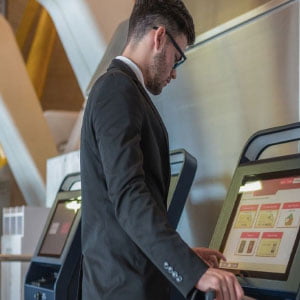When we first saw self-service machines in the supermarket
Anyone remembers how self-service started? Some of us saw for the first time these machines in the banks, but they probably didn’t caught up our attention until we saw them in the supermarket, with their screens and scanners which with you could literally do the job of the cashier. At the beginning people could be split in 2 groups: The ones that wanted to try them and the ones that were swearing they would always queue at the cashier.
After some years, we all know that the vast majority of us go straight away to the self-service machine even if we see that there is a cashier. Maybe because it is faster, maybe because nowadays there are more kiosks than cashiers or maybe because it is just the habit. And the same thing happens with all the new technology that arises: Smartphones, social media, computers, smart TV, smart watches, online banking, ecommerce, online education, 5G, … We were all reluctant to change at the beginning, until it started being usual, we adapted to it, we embraced it and now it seems impossible to live without one of these technologies.
Self-service kiosks expansion in different industries
The same is happening with self-service technology. Self-service kiosks are not anymore only in the supermarkets or selling some products on the street. Now we can find them in the banks, airports, hospitals, public transport, clothing stores, petrol stations, restaurants, and we could make a non-ending list about them. But, why there are some sectors like banking, that seem to adapt faster to self-service technology while there are other sectors like Hospitality, where self-service seems to generate some fears?
It seems it all depends on the vision of the company, the line between the tasks that should be automated and the ones that should be carried out by the staff, and the understanding that companies have about customer service. Be able to understand what processes the customer would prefer to be digital requires some research and testing.
But where’s the line between human and artificial tasks?
Self-service technology has been introduced to perform automated tasks. Tasks that are usual, repeated, quite simple and that may not require further assistance are the key tasks that self-service kiosks perform in different sectors like banking. People don’t want to queue in a bank branch only to take or introduce some money into their account or to do a bank transfer, a barcode payment, etc. Bank clients only want to queue or get an appointment with the bank staff in cases where they have to do something more complex or that requires some assistance and extra information, such as asking for a loan or investing.
In these situations that don’t require further assistance and where the process can be smoother and faster with a self-service kiosk, why not using them? In the end, it is about making customer’s life easier, to speed up the processes they need to go through and to make their experience better.
Every day we can find more self-service kiosks everywhere, and now the trend arrived to restaurants. Mc Donalds already implemented them some years ago -there’s always a big company taking the first step and shaping the future of the industry. With time, digital kiosks were allocated in plenty of restaurant chains and lately they started appearing in smaller, casual restaurants. Their expansion to other types of restaurants is about time, and this future is not too far away. Why delaying something that will make our life easier and more comfortable?
Kayana leading the customer service revolution
Future is in the hands of those who know how to anticipate to it. Self-service is already a reality and it will be the future of a lot of businesses. Kayana offers self-service solutions for food and beverage businesses: from self-service kiosks to mobile app ordering and payment services.
Self-service cuts ordering and payment time, allowing customers to be served faster, leave whenever they want after their meal, and avoid queues, which translates into more clients to be served, and in consequence, restaurant’s sales increase.
Self-service does not only speed up the process, but it also improves customer service. It offers a visual, interactive menu to customers, so clients will be able to see how the food they wish to order looks like, which will reduce unexpected dishes and show them other options that they could miss in a traditional menu.
Moreover, restaurant staff will be freed up to focus in what really matters: customer service. Have you ever gone to a restaurant and you needed a sauce, another drink, a new fork, but it was impossible to ask for it because the waiters were too busy? Kayana solves this problem and puts customer experience in the centre of its services.
Customer-centric, future-focused, Kayana.
Yolanda Mir


